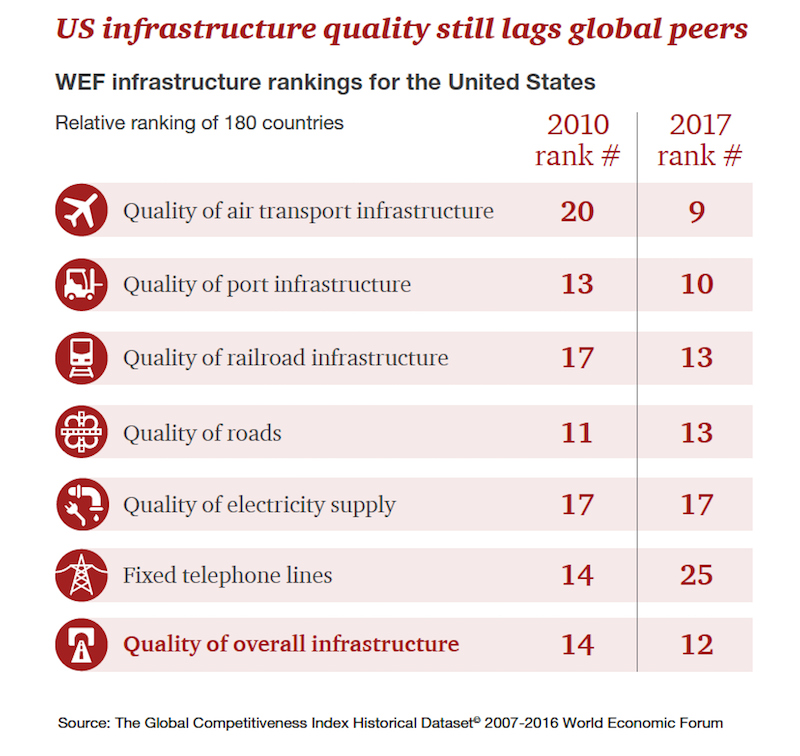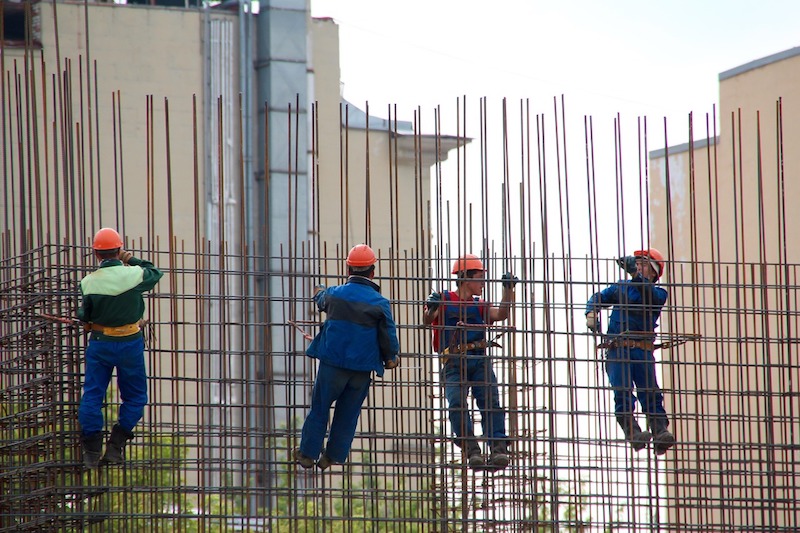The most likely beneficiaries of new infrastructure investment in the U.S. would be the engineering, construction, and industrial manufacturing sectors. And as government officials debate the next major infrastructure stimulus plan, PwC, the accounting and consulting firm, argues in a new study that industrial products and services companies must think proactively about positioning themselves as suppliers, planners, and even investors to help direct which infrastructure projects get funded, and how they are paid for.
The Trump Administration and the leadership of the Democratic Party have each come up with programs to infuse an estimated $1 trillion of infrastructure spending into the economy over the next decade. Those plans roughly align on where that investment is most heavily needed. Where they diverge—or at least are presumed to diverge, as details remain unclear—is primarily over how projects would be funded.
The Democrats’ plan would be chiefly debt financed, but also includes a $10 billion provision for an infrastructure bank to extend loan guarantees and low-cost loans to spur investment. Trump’s plan—which includes paying for a security wall across the U.S.-Mexico that alone could cost up to $25 billion—favors some combination of tax incentives and public-private partnerships, as long as what gets built subscribes to Trump’s “America First” mantra for hiring and product purchasing.
(A stumbling block to new legislation could be Republican budget hawks who have expressed opposition to any plan that isn’t revenue neutral. House Speaker Paul Ryan has gone so far as to state that every dollar of federal money for infrastructure spending must be matched by $40 of private investment. Some Democrats have also objected to the developer-heavy council Trump has assembled to pick and choose projects worthy of stimulus money.)

The U.S. seriously lags behind other industrial nations in the quality of its infrastructure. Image: PwC study “What a U.S. Infrastructure Stimulus Could Mean for the Industrial Sector.”
Meanwhile, the clock keeps ticking on the country’s crumbling bridges, roads, tunnels, and airports. The American Society of Civil Engineers (ASCE) estimates $3.3 trillion of investment is needed to maintain, repair and build new infrastructure through 2025, and sees a funding gap of $1.4 trillion to meet those needs. ASCE expects the gap to widen if current public and private investment trends continue unchanged, and further estimate that the economic impact of not filling the gap will sideline a potential $3.9 trillion GDP boost and 2.5 million jobs.
The public wants dramatic action to be taken, but continues to send out mixed signals about stimulus spending: PwC quotes a recent poll, conducted by Politico and Harvard’s T. H. Chan School of Public Health, which found 61% of Americans favor major new tax credits for business to build roads, bridges, waterways, airports and other infrastructure, while 75% says it was important for these projects to be federally funded.
PwC, though, thinks the time is “ripe” for more P3 activity in the U.S., partly because many states, restricted by balanced budget mandates and their unwillingness to raise taxes, simply can’t afford to take on big projects.
The question, though, is how to get more investors into the game. Through mid 2016, infrastructure funds that target North American assets were sitting on $75 billion in unspent capital. “The attractiveness of U.S. infrastructure [as an investment] needs to improve,” observes PwC.
The accounting firm thinks it “makes sense” to focus more on projects that enhance the America’s global competitiveness. In the latest World Economic Forum’s annual Global Competitive Index, a global ranking of the quality of the business environment, U.S. infrastructure lags other economies across several categories, ranking 12th overall, 13th in quality of roads, and ninth in air transport. Since 1980, public spending in transportation and water infrastructure, as a percentage of GDP, has held at around 2.5% compared to its 1959 peak of 3%. “The trend is hard to dislodge,” states PwC.
The irony is that greater investment pays dividends, if the Obama Administration’s $831 billion stimulus package through the American Recovery and Reinvestment Act of 2009 is any barometer. The Congressional Budget Office (CBO) estimated that real GDP in 2010 was between 0.7% and 4.1% higher and that employment was between 700,000 and 3.3 million jobs greater (measured in employment years) than had the stimulus not been carried out. Over the 2009–2011 period, the number of jobs saved or created by ARRA investment was estimated by CBO to be between 1.4 million and 6.8 million.
PwC asserts that if the Trump Administration dedicated $100 billion per year to rebuilding infrastructure, job creation and business activity in the industrial sector would inevitably follow. “For a sustained effect, a strong emphasis should be placed not only on short-term jobs creation and economic stimulus, but also on long- term impact on productivity rates, sustainability and efficiencies that have strong fiscal multiplier effects. For example, embedding ‘smart’ technology in all new infrastructure is critical, to ensure that infrastructure assets are ‘future proof.’ ”
Perhaps the most controversial part of PwC’s report—and one Trump and many of his supporters would find hard to swallow—is its business-centric view that any infrastructure stimulus plan shouldn’t get too hung up on how many jobs it generates.
“Considering the ongoing shifting nature of jobs,” PwC continues, “as manufacturers adopt advanced manufacturing technologies is just as important as—and perhaps more important than—the number of jobs in the industrial labor force.”
Related Stories
| Jan 19, 2011
Industrial history museum gets new home in steel plant
The National Museum of Industrial History recently renovated the exterior of a 1913 steel plant in Bethlehem, Pa., to house its new 40,000-sf exhibition space. The museum chose VOA Associates, which is headquartered in Chicago, to complete the design for the exhibit’s interior. The exhibit, which has views of five historic blast furnaces, will feature artifacts from the Smithsonian Institution to illustrate early industrial America.
| Jan 19, 2011
San Diego casino renovations upgrade gaming and entertainment
The Sycuan Casino in San Diego will get an update with a $27 million, 245,000-sf renovation. Hnedak Bobo Group, Memphis, Tenn., and Cleo Design, Las Vegas, drew design inspiration from the historic culture of the Sycuan tribe and the desert landscape, creating a more open space with better circulation. Renovation highlights include a new “waterless” water entry feature and new sports bar and grill, plus updates to gaming, poker, off-track-betting, retail, and bingo areas. The local office of San Francisco-based Swinerton Builders will provide construction services.
| Jan 4, 2011
Luxury hotel planned for Palace of Versailles
Want to spend the night at the Palace of Versailles? The Hotel du Grand Controle, a 1680s mansion built on palace grounds for the king's treasurer and vacant since the French Revolution, will soon be turned into a luxury hotel. Versailles is partnering with Belgian hotel company Ivy International to restore the dilapidated estate into a 23-room luxury hotel. Guests can live like a king or queen for a while—and keep their heads.
| Dec 17, 2010
Toronto church converted for condos and shopping
Reserve Properties is transforming a 20th-century church into Bellefair Kew Beach Residences, a residential/retail complex in The Beach neighborhood of Toronto. Local architecture firm RAWdesign adapted the late Gothic-style church into a five-story condominium with 23 one- and two-bedroom units, including two-story penthouse suites. Six three-story townhouses also will be incorporated. The project will afford residents views of nearby Kew Gardens and Lake Ontario. One façade of the church was updated for retail shops.
| Dec 2, 2010
GKV Architects wins best guest room design award for Park Hyatt Istanbul
Gerner Kronick + Valcarcel, Architects, PC won the prestigious Gold Key Award for Excellence in Hospitality Design for best guest room, Park Hyatt Macka Palas, Istanbul, Turkey. Park Hyatt Maçka Palace marries historic and exotic elements with modern and luxurious, creating a unique space perpetuating Istanbul’s current culture. In addition to the façade restoration, GKV Architects designed 85 guestrooms, five penthouse suites, an ultra-hip rooftop bar, and a first-of-its-kind for Istanbul – a steakhouse, for the luxury hotel.
| Nov 29, 2010
Renovating for Sustainability
Motivated by the prospect of increased property values, reduced utility bills, and an interest in jumping on the sustainability bandwagon, a noted upturn in green building upgrades is helping designers and real estate developers stay busy while waiting for the economy to recover. In fact, many of the larger property management outfits have set up teams to undertake projects seeking LEED for Existing Buildings: Operations & Maintenance (LEED-EBOM, also referred to as LEED-EB), a certification by the U.S. Green Building Council.
| Nov 9, 2010
Designing a library? Don’t focus on books
How do you design a library when print books are no longer its core business? Turn them into massive study halls. That’s what designers did at the University of Amsterdam, where they transformed the existing 27,000-sf library into a study center—without any visible books. About 2,000 students visit the facility daily and encounter workspaces instead of stacks.
| Nov 9, 2010
Turner Construction report: Green buildings still on the agenda
Green buildings continue to be on the agenda for real estate owners, developers, and corporate owner-occupants, according to the Turner 2010 Green Building Market Barometer. Key findings: Almost 90% of respondents said it was extremely or very likely they would incorporate energy-efficiency improvements in their new construction or renovation project, and 60% expected to incorporate improvements to water efficiency, indoor environmental quality, and green materials.
| Nov 3, 2010
Designs complete for new elementary school
SchenkelShultz has completed design of the new 101,270-sf elementary Highlands Elementary School, as well as designs for three existing buildings that will be renovated, in Kissimmee, Fla. The school will provide 48 classrooms for 920 students, a cafeteria, a media center, and a music/art suite with outdoor patio. Three facilities scheduled for renovations total 19,459 sf and include an eight-classroom building that will be used as an exceptional student education center, a older media center that will be used as a multipurpose building, and another building that will be reworked as a parent center, with two meeting rooms for community use. W.G. Mills/Ranger is serving as CM for the $15.1 million project.
Office Buildings | Nov 3, 2010
11 tips for office renovation success
Only after you’ve done your homework on these critical success factors can you determine if you can produce a successful office renovation project for your client.
















